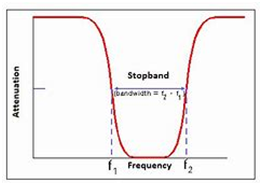
In signal processing, a band-stop filter or band-rejection filter is a filter that passes most frequencies unaltered, but attenuates those in a specific range to very low levels. It is the opposite of a band-pass filter. A notch filter is a band-stop filter with a narrow stop band. Narrow notch filters are used in Raman spectroscopy, live sound reproduction and in instrument amplifiers to reduce or prevent audio feedback, while having little effect on the rest of the frequency spectrum.

Specifications
Material: | H-K9L |
Size: | +/-0.1mm |
Clear aperture: | > 90% |
Parallelism: | < 1 arc minute |
Surface quality: | 60-40 scratch and dig |
Transmitted wavefront, P-V | λ/4 @632.8nm |
Edge: | Ground |
Angle of incidence: | 0 degree |
Center wavelength: | 355, 488, 532, 632.8, 808, 1064nm… |
Band width: | 10 - 60nm |
Blocking depth: | > OD4 |
Transmission: | Tave > 90% |
In signal processing, a band-stop filter or band-rejection filter is a filter that passes most frequencies unaltered, but attenuates those in a specific range to very low levels. It is the opposite of a band-pass filter. A notch filter is a band-stop filter with a narrow stop band. Narrow notch filters are used in Raman spectroscopy, live sound reproduction and in instrument amplifiers to reduce or prevent audio feedback, while having little effect on the rest of the frequency spectrum.

Specifications
Material: | H-K9L |
Size: | +/-0.1mm |
Clear aperture: | > 90% |
Parallelism: | < 1 arc minute |
Surface quality: | 60-40 scratch and dig |
Transmitted wavefront, P-V | λ/4 @632.8nm |
Edge: | Ground |
Angle of incidence: | 0 degree |
Center wavelength: | 355, 488, 532, 632.8, 808, 1064nm… |
Band width: | 10 - 60nm |
Blocking depth: | > OD4 |
Transmission: | Tave > 90% |